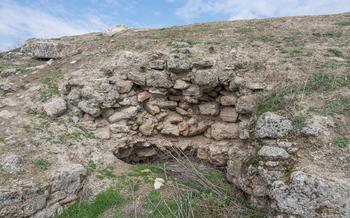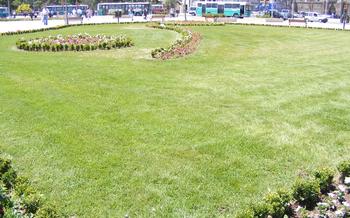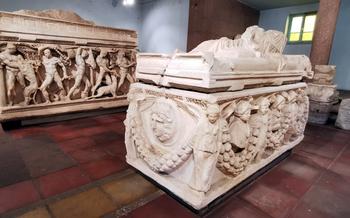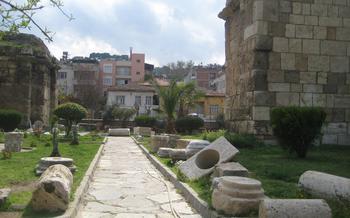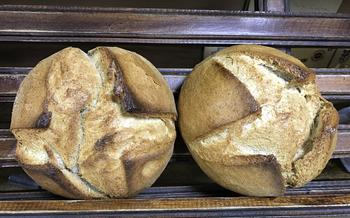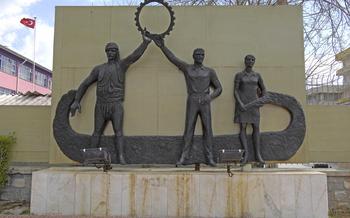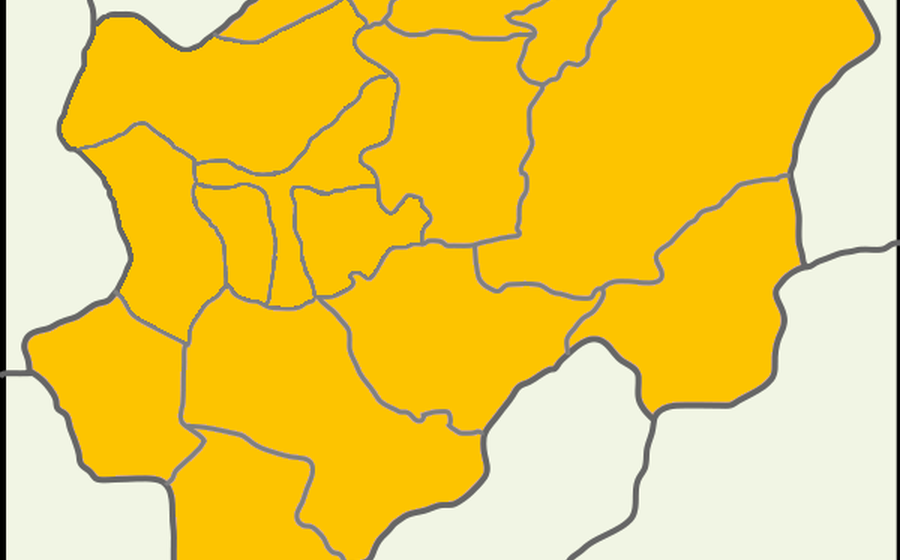
Soysallı Ancient City
- The Antiquity of Soysallı
- Exploring the Ruins
- Mosaics and Frescoes: A Glimpse into Soysallı's Artistic Heritage
- Religious Structures
- Aqueducts and Water Systems
- Agora and Market
- Residential Areas: A Window into Ancient Soysallı's Domestic Life
- Defensive Structures: Protecting Soysallı from Invaders
- Public Baths: Rituals of Cleanliness and Socialization
- Hippodrome and Entertainment
- Necropolis and Tombs
- Excavations and Ongoing Research
- Visiting Soysallı Today: A Journey Through Time
- Insider Tip: Unveiling Soysallı's Hidden Treasures
The Antiquity of Soysallı
History and Significance: Soysallı Ancient City, known in ancient times as Eusebia, boasts a rich and storied past dating back to the Roman period. Strategically located along ancient trade routes, it served as a vital hub connecting the Roman provinces of Cappadocia and Cilicia. Archaeological excavations have unearthed impressive remains of public buildings, temples, and residential areas, shedding light on the city's significance as a thriving commercial and administrative center.
Archeological Discoveries: Excavations at Soysallı have yielded a treasure trove of artifacts and architectural elements, providing valuable insights into the city's history and culture. Exquisite mosaics depicting mythological scenes and geometric patterns adorn the floors of public buildings, while finely carved statues and inscriptions offer glimpses into the lives and beliefs of Soysallı's inhabitants. These discoveries have contributed significantly to our understanding of Roman and early Byzantine urban life in central Anatolia.
Role in Ancient Trade: As a key stopover on ancient trade routes, Soysallı played a pivotal role in facilitating commerce and cultural exchange. The city's strategic location allowed it to serve as a conduit for goods and ideas between the Roman Empire and its eastern provinces. Merchants from across the region converged in Soysallı, contributing to the city's prosperity and cosmopolitan atmosphere.
Cultural Influences and Heritage: Soysallı's position as a crossroads of cultures resulted in a unique blend of influences reflected in its urban fabric. Architectural styles showcased elements of Roman, Greek, and local Anatolian traditions, creating a harmonious synthesis of artistic and cultural expression. The city's rich heritage is a testament to the vibrant cultural exchange that characterized this region during antiquity.
Exploring the Ruins
Soysallı Ancient City offers a captivating glimpse into the urban landscape of the past. The city's ruins are spread across a vast area, revealing a well-organized layout that speaks volumes about the advanced planning and engineering skills of its ancient inhabitants.
-
Temples: The city was home to several temples, each dedicated to a different deity. These temples showcased impressive architectural features, including intricate carvings, decorative columns, and grand entrances. The Temple of Zeus, with its towering columns and well-preserved mosaics, stands as a testament to the city's religious devotion.
-
Baths: Soysallı boasted an extensive network of public baths, reflecting the importance of bathing rituals in ancient Roman and Byzantine cultures. These baths featured separate sections for men and women and included facilities such as changing rooms, hot and cold pools, and saunas. The well-preserved remains of these baths provide insights into the daily routines and hygiene practices of Soysallı's residents.
-
Theaters: The city's theaters served as venues for entertainment and cultural events. The most notable theater, known as the Odeon, could accommodate up to 2,000 spectators and hosted performances of plays, musical concerts, and other artistic presentations. The theater's acoustics and impressive stage design allowed for immersive experiences that transported audiences to different worlds.
Mosaics and Frescoes: A Glimpse into Soysallı's Artistic Heritage
The ruins of Soysallı are adorned with a treasure trove of mosaics and frescoes, offering visitors a glimpse into the city's rich artistic heritage. These artworks, painstakingly crafted by skilled artisans, showcase a variety of styles and techniques, ranging from intricate geometric patterns to vivid depictions of human figures and mythological scenes.
The mosaics, composed of colorful tesserae, often adorned the floors of public buildings and wealthy residences. They depict a wide range of subjects, from everyday life to religious themes. One particularly notable mosaic features a detailed representation of a chariot race, capturing the excitement and intensity of this ancient sport.
The frescoes, painted directly onto the walls of buildings, display a remarkable level of artistry and technical skill. They depict a variety of scenes, including religious narratives, historical events, and mythological tales. The vibrant colors and expressive figures bring these stories to life, offering visitors a glimpse into the beliefs and values of Soysallı's ancient inhabitants.
Beyond their aesthetic value, these mosaics and frescoes provide valuable insights into the cultural influences that shaped Soysallı. The styles and techniques employed reveal connections to both Roman and Byzantine art, reflecting the city's position as a crossroads of civilizations.
Conservation efforts are underway to preserve these precious artworks for future generations. Specialized techniques are used to clean and restore the mosaics and frescoes, ensuring that their beauty and significance can continue to be appreciated by visitors for years to come.
Religious Structures
Soysallı was a melting pot of religions, with a significant presence of Christianity and other ancient faiths. The city's religious landscape was marked by the construction of several churches and other religious buildings, each reflecting the diverse beliefs and practices of its inhabitants.
-
Churches: The most prominent religious structures in Soysallı were its churches, which served as centers of worship and community gatherings. These churches showcased various architectural styles, from the simple basilicas to more elaborate structures with intricate decorations. The churches often featured impressive mosaics and frescoes depicting biblical scenes and religious figures, offering a glimpse into the spiritual beliefs of the city's Christian population.
-
Other Religious Buildings: In addition to churches, Soysallı was home to other religious buildings, such as synagogues and Mithraic temples. These structures catered to the needs of the city's Jewish and Mithraic communities, respectively. The presence of these diverse religious buildings highlights the tolerance and religious diversity that characterized ancient Soysallı.
-
Historical Context: The religious practices in Soysallı were influenced by the broader historical context of the region. The city was part of the Roman Empire, which initially tolerated various religions. However, with the rise of Christianity as the official religion of the empire, Christian churches became more prominent, while other religions faced restrictions. The presence of religious buildings in Soysallı reflects the complex religious dynamics that existed during the Roman and Byzantine periods.
-
Cultural Heritage: The religious structures of Soysallı played a vital role in shaping the city's cultural heritage. These buildings served as places of worship, education, and community gatherings, fostering a sense of unity and belonging among the city's inhabitants. The diversity of religious buildings in Soysallı also contributed to the city's rich cultural tapestry, showcasing the different beliefs and practices that coexisted within its walls.
Aqueducts and Water Systems
In ancient Soysallı, access to a reliable water supply was crucial for the city's survival and prosperity. The inhabitants demonstrated remarkable engineering skills by constructing an intricate system of aqueducts that channeled water from distant mountain springs into the heart of the city. These aqueducts, some of which stretched for several kilometers, were marvels of hydraulic engineering. Built using stone and mortar, they followed the natural contours of the land, skillfully navigating hills and valleys to ensure a steady flow of water.
The aqueducts not only supplied water for domestic use but also played a vital role in the city's agricultural and industrial activities. Farmers relied on irrigation to cultivate crops, while artisans used water for various industrial processes, including pottery, metalworking, and textile production. The availability of water also contributed to the city's public health and sanitation, as it allowed for the construction of public baths, fountains, and drainage systems.
Exploring the remains of Soysallı's aqueducts offers a glimpse into the ingenuity and resourcefulness of its ancient inhabitants. Visitors can trace the course of the aqueducts, marveling at their construction and imagining the vital role they played in shaping the daily lives of Soysallı's people.
Agora and Market
The agora, or marketplace, was the central hub of economic activity in ancient Soysallı. Situated in the heart of the city, it served as a bustling center for trade, commerce, and social interactions. The agora was a rectangular open space surrounded by shops, stalls, and public buildings.
The shops and stalls in the agora sold a wide range of goods, including food, clothing, pottery, jewelry, and tools. Merchants from neighboring cities and regions brought their wares to Soysallı, making the agora a melting pot of cultures and traditions. The market was also a place where farmers sold their produce and livestock, ensuring a steady supply of fresh food for the city's inhabitants.
The agora was not merely a place of commerce but also a vital social and cultural center. People gathered here to exchange news, gossip, and ideas. Philosophers and orators gave speeches, while musicians and performers entertained the crowds. The agora was a place where people from all walks of life came together to conduct business, socialize, and participate in the vibrant urban life of ancient Soysallı.
Residential Areas: A Window into Ancient Soysallı's Domestic Life
Within the ancient city of Soysallı, the residential areas provide a glimpse into the domestic lives of its inhabitants. Typical houses in Soysallı were constructed using local stone and featured a courtyard surrounded by rooms. These courtyards served as central living spaces, where families gathered for meals, engaged in household activities, and socialized. The rooms surrounding the courtyard had various functions, including bedrooms, kitchens, storage areas, and workshops.
The architectural features of the houses varied depending on the social status and wealth of the occupants. Wealthier families often had larger houses with more elaborate decorations, such as mosaics and frescoes. These decorations often depicted scenes from mythology, nature, or everyday life, offering insights into the cultural and aesthetic preferences of Soysallı's residents.
The residential areas also reveal the social structure and family life in ancient Soysallı. Extended families often lived together in the same household, and the courtyard served as a communal space where family members interacted and shared responsibilities. The presence of separate rooms for various functions suggests a division of labor within the household, with women primarily responsible for domestic tasks and men engaged in agricultural or trade activities.
By exploring the residential areas of Soysallı, visitors can gain a deeper understanding of the daily lives, social customs, and family dynamics of the people who once called this ancient city home.
Defensive Structures: Protecting Soysallı from Invaders
Soysallı's strategic location made it a prime target for invasion and attack throughout its history. To protect themselves from these threats, the city's inhabitants constructed a series of impressive defensive structures.
The most prominent of these fortifications was the city walls, which encircled Soysallı and provided a formidable barrier against enemy forces. The walls were constructed using large blocks of stone and featured towers and gates at regular intervals. The towers allowed defenders to keep watch for approaching enemies and provided a vantage point from which to launch projectiles. The gates were heavily fortified and could be closed and locked to prevent entry.
In addition to the city walls, Soysallı also had a number of other defensive features. These included a moat, which surrounded the city and made it more difficult for attackers to approach, and a series of earthen ramparts, which were built on the outskirts of the city to provide an additional layer of protection.
The defensive structures of Soysallı were put to the test on several occasions throughout the city's history. In the 3rd century AD, the city was besieged by the Sassanid Persians. The Sassanids were unable to penetrate the city's defenses, and they were forced to retreat. In the 7th century AD, Soysallı was besieged by the Arab Muslims. The Arabs were more successful than the Persians, and they eventually captured the city. However, the city's fortifications remained intact, and they continued to be used by the Arabs and their successors for centuries to come.
The defensive structures of Soysallı are a testament to the ingenuity and resilience of the city's inhabitants. These structures played a vital role in protecting the city from invasion and attack, and they helped to ensure its survival for over a thousand years.
Public Baths: Rituals of Cleanliness and Socialization
In Soysallı, public baths played a crucial role in the daily lives of its inhabitants. These impressive structures were not merely places for bathing but also served as significant social and cultural hubs. The baths were inspired by Roman and Byzantine bathing traditions, featuring distinct architectural elements and layouts.
Central to the bath complex was the frigidarium, a large, cold-water pool used to rinse off after sweating in the heated rooms. The tepidarium, a warm-water room, provided a gradual transition between the frigidarium and the hottest chamber, the caldarium. The caldarium featured a large, heated pool and a domed ceiling that allowed steam to circulate, creating a soothing and relaxing atmosphere.
Beyond their practical function, public baths held deep cultural and social significance. They were places where people from all walks of life gathered to socialize, exchange news, and engage in leisurely activities. The baths were also venues for athletic competitions, musical performances, and philosophical discussions.
The intricate mosaic floors and frescoes that adorned the baths added to their grandeur and artistic value. These artworks depicted scenes from mythology, nature, and daily life, providing glimpses into the cultural and aesthetic sensibilities of the period.
The public baths of Soysallı stand as testaments to the advanced engineering and architectural prowess of ancient civilizations. They offer a fascinating glimpse into the bathing rituals, social customs, and hygienic practices of the people who once called this city home.
Hippodrome and Entertainment
In the heart of Soysallı's ancient city, a magnificent hippodrome once stood as a testament to the city's vibrant social life and love of entertainment. This grand arena, modeled after the iconic hippodromes of the Roman Empire, hosted exhilarating chariot races that captivated the hearts of spectators. The hippodrome's elongated track, lined with tiers of seating, provided an immersive experience for the cheering crowds.
Beyond chariot races, the hippodrome served as a versatile venue for a variety of spectacles and events. Gladiatorial contests, acrobatic performances, and theatrical productions brought the community together, fostering a sense of shared excitement and camaraderie. These events not only entertained but also showcased the skills and talents of the performers, adding to the city's cultural tapestry.
Necropolis and Tombs
The necropolis of Soysallı offers a glimpse into the burial customs and beliefs of its ancient inhabitants. Located outside the city walls, the necropolis contains a variety of tombs, ranging from simple graves to elaborate mausoleums. These tombs provide valuable insights into the social structure and funerary practices of Soysallı's population.
Among the most notable tombs in the necropolis are those of wealthy families and prominent individuals. These tombs are often adorned with intricate carvings, sculptures, and inscriptions that provide information about the deceased and their families. The necropolis also contains a number of communal tombs, where multiple individuals were buried together. These tombs often belonged to families or religious groups.
Archaeological excavations at the necropolis have uncovered a wealth of artifacts, including jewelry, pottery, and coins. These artifacts provide further insights into the lives and customs of Soysallı's inhabitants. The necropolis is an important part of the ancient city and offers visitors a chance to learn more about the beliefs and practices of its people.
Excavations and Ongoing Research
Soysallı has been the subject of extensive archaeological excavations since the early 20th century. These excavations have uncovered a wealth of artifacts and structures, shedding light on the city's rich history and significance. One of the most significant discoveries was the unearthing of a large number of mosaics and frescoes, which provide valuable insights into the artistic and cultural traditions of Soysallı.
Ongoing research projects continue to explore various aspects of Soysallı's past. Archaeologists are working to understand the city's urban planning, economic activities, and social structure. Recent excavations have focused on uncovering residential areas, public buildings, and religious structures, providing a more comprehensive picture of daily life in ancient Soysallı.
The challenges of excavating and preserving Soysallı are significant. The site is vast, and much of it remains unexcavated. Additionally, the harsh climate and the passage of time have taken their toll on the ruins, making it difficult to interpret and conserve them.
Despite these challenges, ongoing research at Soysallı is crucial for understanding the history and significance of this ancient city. Through careful excavation and analysis, archaeologists are piecing together the story of Soysallı, revealing its role in the development of ancient Anatolia and providing valuable insights into the lives of its inhabitants.
Visiting Soysallı Today: A Journey Through Time
Soysallı Ancient City welcomes visitors with open arms, inviting them to embark on a journey through time. Reaching the site is a breeze, thanks to its proximity to Kayseri and well-maintained transportation links. Guided tours are readily available, providing insightful narratives that bring the ancient city to life.
Before you set foot on Soysallı's historic grounds, take a moment to soak in its surroundings. The picturesque landscapes that envelop the city create a breathtaking backdrop for your exploration. As you wander through the ruins, let your imagination soar, envisioning the bustling streets and vibrant life that once filled this ancient metropolis.
Remember, Soysallı is a precious heritage site, and its preservation is vital. Tread lightly and respectfully, leaving no trace of your visit. Embrace the role of a responsible traveler, contributing to the protection of this irreplaceable treasure for future generations.
Insider Tip: Unveiling Soysallı's Hidden Treasures
Beyond the well-known ruins and attractions of Soysallı, there lies a hidden gem waiting to be discovered—the ancient underground reservoir. This remarkable engineering feat served as a vital water source for the city's inhabitants, ensuring a steady supply even during droughts. Explore this hidden chamber and marvel at the ingenuity of ancient civilizations as you witness the intricate system of channels and tunnels that transported water throughout the city. Remember to bring a flashlight to fully illuminate the depths of this subterranean wonder.
Soysallı is also home to a lesser-known Byzantine church located on the outskirts of the city. While not as grand as the main churches within the city walls, this hidden gem offers a glimpse into the religious practices and architectural styles of the Byzantine era. Admire the well-preserved frescoes and mosaics that adorn the interior, depicting scenes from the Bible and the lives of saints. Take a moment to reflect on the spiritual significance of this site and the role it played in shaping the religious landscape of ancient Soysallı.
When exploring Soysallı, it's important to be mindful of local customs and etiquette. As a visitor, always dress respectfully and avoid wearing revealing clothing, especially when visiting religious sites. Remember to greet locals with a warm smile and a friendly "Merhaba" (hello). Respecting local traditions shows your appreciation for their culture and helps preserve the integrity of this ancient city.

